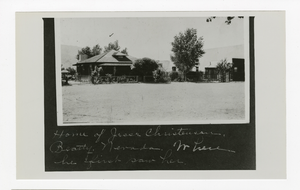Search the Special Collections and Archives Portal
Search Results

Transcript of interview with Brian Block by Diane Spero, February 27, 1979
Date
Archival Collection
Description
Text

Photograph of Jesse Christensen home, Bullfrog Hills (Nev.), early 1900s
Date
Archival Collection
Description
Caption: Home of Jesse Christensen. Beatty, Nevada, where he first saw her.
Image

Transcript of interview with Lee Cagley by Claytee D. White and Stefani Evans, August 08, 2016
Date
Archival Collection
Description
Lee Cagely, an interior designer and professor who designed some of the most iconic hotels in Las Vegas, Nevada, was born in the Panama Canal Zone on January 31, 1951. His father Leo was a civil engineer for the Panama Canal Company and his mother Charlotte worked as a receptionist. After his father left his job in Panama, Lee spent his childhood in Dallas, Texas; Tulsa, Oklahoma; and Des Moines, Iowa. He started to attend Rice University for architecture, but he chose to leave before completing his degree. He returned to college a few years later and graduated from Iowa State University with a degree in interior design in 1975. While his first California jobs were in restaurant design, he quickly moved on to airports and hotels and moved to Las Vegas in 1990 after associating with Marnell Architecture. Cagley is known for his designs in the Rio All-Suite Hotel and Casino, Ceasars Palace Atlantic City, the Mirage, and the Bellagio Resort & Casino. He is currently Chair of the Iowa State University College of Design and is principal designer for Lee Cagely Design. Here, Cagley explains the importance of keeping the various pieces of the infrastructure of a resort—including landscape architecture, architecture, interior design, all kinds of HVAC [heating, ventilation and air conditioning] concerns, housekeeping, food service, maintenance, etc.-invisible in order to maximize the visitor experience. At the same time he illustrates through several examples how resort design does not happen in a vacuum-it is instead part of a complex team that works together to create the whole. He also describes the challenges the Las Vegas resort industry finds in creating the very best visitor experience for a broad range of groups-from Millennials to their Boomer grandparents and all the generations in between.
Text

Domingo Cambeiro oral history interview: transcript
Date
Archival Collection
Description
Oral history interview with Domingo Cambeiro conducted by Stefani Evans and Claytee D. White on October 18, 2016 for the Building Las Vegas Oral History Project. In this interview, Cambeiro discusses his upbringing in Havana, Cuba. He talks about his initial interests in architecture, starting his own architecture drawing service, and attending the University of Havana. Cambeiro recalls submitting a request to leave Cuba, emigrating to the United States, and arriving in Las Vegas, Nevada in 1962. Cambeiro talks about working with Las Vegas architect Julius Gabriel, obtaining his architecture license, and starting an architectural firm. Lastly, Cambeiro discusses being selected to create architectural drawings for the Thomas & Mack Center.
Text
Brian Block oral history interview
Identifier
Abstract
Oral history interview with Brian Block conducted by Diane Spero on February 27, 1979 for the Ralph Roske Oral History Project on Early Las Vegas. Block discusses the construction business, community planning, architectural design, and his personal feelings in regard to the development of the Las Vegas, Nevada area. Block also discusses legalized gambling, politics, mass transit problems, and other social and environmental changes in Nevada.
Archival Collection

Transcript of interview with Randy Lavigne by Stefani Evans and Clatyee D. White, August 23, 2016
Date
Archival Collection
Description
Randy Lavigne, Honorary AIA, has every reason to smile. Since 1995 she has been the Executive Director for AIA (American Institute of Architects) Las Vegas professional organization; she works daily with her daughter in a beautifully restored historic building in the heart of downtown Las Vegas; and the architects with whom she works so value her contributions they compiled and submitted documentation in order to surprise her with honorary AIA membership. In this interview, Lavigne recalls growing up in segregated Emory Gap, Tennessee, where her grandfather bought all the schoolchildren new shoes every year. She details the cross-country trip that brought her to Las Vegas in 1994 and eventually to the AIA in 1995. The bulk of the interview focuses on the building where the AIA is housed and the history of the organization. In 2008 the AIA moved from its former home at UNLV’s School of Architecture to the historic Fifth Street School in downtown Las Vegas. Lavigne discusses the history of the building and its significance to the City of Las Vegas. She reveals plans to examine the architectural history Las Vegas to celebrate the AIA Chapter’s sixtieth anniversary. She also talks about diversity in the profession, the process of licensure, publications, continuing education, organizational records, and the now-defunct auxiliary organization, the Architects' Wives League.
Text
Dave Pugsley oral history interview
Identifier
Abstract
Oral history interview with Dave Pugsley conducted by Stefani Evans and Claytee D. White on October 21, 2016 for the Building Las Vegas Oral History Project. In this interview, Pugsley discusses his early life in Salt Lake City, Utah and moving to Las Vegas, Nevada in 1963. He talks about his father’s employment with Young Electric Sign Company (YESCO) and the Nevada Test Site. Pugsley recalls his initial interest in architecture, drawing a construction document for the Home Builders Association while in high school, and attending the University of Utah for a degree in architecture. Pugsley then talks about building planning for schools in Clark County, the process of designing a school, and the challenges that arise. Lastly, Pugsley discusses building planning for Lied Library and the William S. Boyd School of Law at the University of Nevada, Las Vegas (UNLV).
Archival Collection
Jane Fielden, Laura Jane Fielden Spina, and Bob Fielden oral history interviews
Identifier
Abstract
Oral history interviews with Jane Fielden, Laura Jane Fielden Spina, and Bob Fielden conducted by Claytee D. White and Stefani Evans on May 27, 2016 and June 27, 2016 for the Building Las Vegas Oral History Project. In the first interview, Jane and Robert discuss their upbringing and early interest in architecture. They talk about arriving to Las Vegas, Nevada in 1964, and forming their construction company RAFI Architecture and Design. They talk about changes in the Las Vegas economic structure during the late 1970s, and projects for the library district, the University of Nevada, Las Vegas (UNLV), and Maryland Parkway. In the second interview, Laura Jane discusses her upbringing in Las Vegas, Nevada. She talks about becoming an interior designer and becoming president of RAFI Architecture and Design. Lastly, Jane, Laura, and Bob discuss improving the quality of lives through architecture.
Archival Collection
Agnes and Emory Lockette oral history interview
Identifier
Abstract
Oral history interview with Agnes and Emory Lockette conducted by Claytee D. White on March 11, 2005 for the Boyer Early Las Vegas Oral History Project. In this interview, Emory discusses his education in architectural and structural engineering. Agnes describes her education in early childhood education, teaching in the Westside and at the University of Nevada, Las Vegas (UNLV). Emory then recalls his employment at the Bureau of Reclamation. Lastly, the two share their active involvement with the Boulder City, Nevada community.
Archival Collection
Edward Vance oral history interview
Identifier
Abstract
Oral history interview with Edward Vance conducted by Stefani Evans and Claytee D. White on September 16, 2016 for the Building Las Vegas Oral History Project. In this interview, Vance discusses his upbringing in Redfield, South Dakota. He talks about his move to Las Vegas, Nevada in 1987, teaching architectural drawing at the University of Nevada, Las Vegas (UNLV), and the first projects he worked on in Las Vegas. Vance describes the financial aspects of architecture, the challenges of meeting building regulations, and benefits that new buildings bring to city life. Lastly, Vance discusses founding Ed Vance & Associates Architects.
Archival Collection
